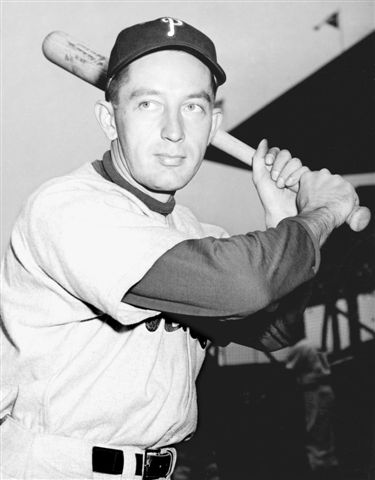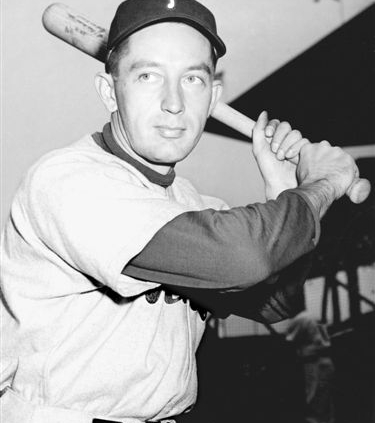August 19, 1949: Roberts and Ashburn key Phillies win on Eddie Waitkus Night
 On the night of June 14, 1949, Philadelphia Phillies first baseman Eddie Waitkus was shot in the chest by a deranged admirer, Ruth Ann Steinhagen, in a Chicago hotel.1 Hours earlier, at Wrigley Field, Waitkus – a Chicago Cub until a December 1948 trade brought him to Philadelphia – had a hit, a walk, and two runs scored in the Phillies’ 9-2 win over the Cubs. That evening, after celebrating with former Chicago and now Philadelphia teammates Russ Meyer and Bill Nicholson, Waitkus returned to the Edgewater Beach hotel, where Steinhagen was waiting for him.2
On the night of June 14, 1949, Philadelphia Phillies first baseman Eddie Waitkus was shot in the chest by a deranged admirer, Ruth Ann Steinhagen, in a Chicago hotel.1 Hours earlier, at Wrigley Field, Waitkus – a Chicago Cub until a December 1948 trade brought him to Philadelphia – had a hit, a walk, and two runs scored in the Phillies’ 9-2 win over the Cubs. That evening, after celebrating with former Chicago and now Philadelphia teammates Russ Meyer and Bill Nicholson, Waitkus returned to the Edgewater Beach hotel, where Steinhagen was waiting for him.2
Waitkus was a popular player for the Cubs in 1946, when the 16-year-old Steinhagen’s obsession began. She frequently attended games at Wrigley Field, and her mother later said he was all she talked about. Waitkus’s trade to Philadelphia did not quell her fixation. “I kept thinking I will never get him and if I can’t have him nobody else can,” she said later.3
The shot pierced Waitkus’s lung and was lodged near his spine. He was in grave condition when he was taken to Illinois Masonic Hospital. It took four operations to stabilize the wound. When Waitkus returned to Philadelphia on July 17 to convalesce, 500 fans braved the pouring rain to greet him.4
His absence cost the Phillies’ lineup one of its strongest contributors. At the time of the shooting, Waitkus was entrenched in the third spot, batting .306 for the fourth-place team. Philadelphia had not finished with a winning record since 1932, and its most recent winning season before that was in 1917.
The 1949 Phillies were 37-28 on June 25, but by early August they were in their worst slump of the season, and had dropped to fifth place in the National League with a record below .500. On August 16, before the start of a three-game series in Brooklyn, Phillies manager Eddie Sawyer called a clubhouse meeting with the intention of igniting a spark. “I know … that you are not hustling as you were earlier in the year,” he told the team. “I feel that if everyone gets down to business, we can finish in the first division. We have the men to do it.”5
The Phillies won all three games in Brooklyn, knocking the Dodgers out of first place. They headed home for a rematch with the Giants. Before the Friday, August 19, contest, the organization honored Waitkus in a pregame ceremony. The 29-year-old Waitkus donned his uniform for the first time since June 14, though he did not play.
Waitkus was warmly welcomed by the crowd of 19,654 at Shibe Park.6 Among the numerous gifts he received from his admirers was a bronzed first baseman’s mitt with signatures of his teammates and the sportswriters who covered the team. “I don’t know what the future holds for me, but you have given me something I will never forget,” said Waitkus, thanking the Phillies officials and fans.7
After the celebration, the Phillies’ Robin Roberts and the Giants’ Dave Koslo faced off in a rematch of the first game of the August 14 doubleheader in New York, won by the Giants, 8-1. In that contest, the Giants drove Roberts from the mound with four runs in 1⅔ innings. Koslo went the distance for his eighth win of the season and his 10th straight over the Phillies.
Roberts got off to a strong start, setting the Giants down in order in the first. In the bottom of the inning, Phillies leadoff hitter Richie Ashburn stroked a single to center. The 22-year-old center fielder – who, like Roberts, had made his major-league debut in 1948 – was following up a productive rookie season, in which he batted .333 and led the majors in stolen bases.
One out later, Dick Sisler, who was playing first base in Waitkus’s absence, lined a smash down the right-field line. New York’s Willard Marshall fumbled the ball, allowing Ashburn to score the first Phillies run. Del Ennis walked, but both runners were stranded as Stan Hollmig struck out and Willie Jones popped out.
The Phillies added another run in the third inning. With two outs, Sisler doubled off the right-field wall. Ennis was intentionally walked, and Hollmig dropped a single into center, driving in Sisler.
Roberts shut the Giants down in the second and third, collecting three strikeouts. With one out in the fourth, he walked Whitey Lockman. Bobby Thomson hit a grounder to third baseman Jones. Lockman, who was running on the pitch, appeared to beat Jones’s throw to second, but umpire Lee Ballanfant called Lockman out, squelching the Giants’ momentum.8
Ashburn’s double to lead off the bottom of the fifth turned into the Phillies’ third run. He moved to third on Granny Hamner’s base hit and scored on Sisler’s sharply hit double-play grounder to second baseman Hank Thompson.
The Giants still had not got a hit off Roberts when Giants pitcher Koslo led off the sixth. Coming off three straight losses, Roberts was pitching one of his best games of the year.9 The 22-year-old right-hander was aiming for his 11th win of the season and his first career win over the Giants.
Koslo broke up the no-hitter with a ground single to right. Roberts retired Thompson on a fly ball to center but Lockman and Thomson followed with singles to drive in Koslo, cutting the deficit to 3-1. With Roberts in his first spot of trouble, cleanup hitter Johnny Mize lined into a second-to-first double play to end the threat.
Koslo returned to the mound in the sixth, but faced only two batters before leaving the game. After Jones doubled and Mike Goliat tripled, reestablishing the Phillies’ three-run lead, Giants manager Leo Durocher replaced Koslo with Hank Behrman, pitching in the last of his four big-league seasons.
Andy Seminick and Roberts walked to load the bases. Ashburn hit a bouncer that scooted past first baseman Mize, allowing Goliat and Seminick to score for a 6-1 lead. Koslo’s final tally showed 10 hits and 5 runs surrendered as his 10-game winning streak over the Phillies ended.
Roberts’ only other ticklish situation came in the eighth. Wes Westrum and pinch-hitter Joe Lafata singled and Thompson walked to load the bases. With the heart of the order due up, Roberts escaped unblemished when Lockman and Thomson popped out and Mize flied out to shallow left field.
Ashburn and Sisler combined to produce the Phillies’ final run in the bottom of the eighth. Reliever Andy Hansen ceded a one-out single to Ashburn, his fourth hit of the game. Ashburn stole second, and one out later Sisler drove him in with a double to right field. Roberts dispatched the Giants in the ninth, and the 7-1 Phillies’ victory was their fourth in a row since Sawyer’s clubhouse meeting.
Waitkus hoped to rejoin the team for the stretch drive, “but that’ll be up to the doctors,” he said.10 He wasn’t able to make it back, but the inspired Phillies finished in third place with an 81-73 record, breaking the franchise’s run of 16 consecutive losing seasons. The Giants finished in fifth with a 73-81 record and two ties.
After a rigorous offseason training program, Waitkus returned as Philadelphia’s first baseman in 1950. He started all but four games at first, scored 102 runs, and was named the Associated Press’s Comeback Player of the Year. The Phillies – known as the Whiz Kids for young talent like Roberts, Ashburn, Ennis, Jones, and pitcher Curt Simmons – won their first pennant since 1915. Durocher and the Giants succeeded the Phillies as NL champions in 1951, though neither the Phillies nor the Giants were able to beat the dynastic New York Yankees in the World Series.
Waitkus played five more years in the majors with Philadelphia and Baltimore before retiring in 1955 at the age of 36. He was never really able to recover emotionally from the shooting, and his post-baseball career was particularly difficult. He battled depression and alcoholism and endured a nervous breakdown before succumbing to cancer just after his 53rd birthday.11
Acknowledgments
This article was fact-checked by Mike Huber and copy-edited by Len Levin.
Photo credit: Eddie Waitkus, National Baseball Hall of Fame Library.
Sources
In addition to the sources cited in the Notes, the author consulted Baseball Reference and Retrosheet for information including the box score and play-by-play.
https://www.baseball-reference.com/boxes/PHI/PHI194908190.shtml
https://www.retrosheet.org/boxesetc/1949/B08190PHI1949.htm
Notes
1 Heide Samuelson, “The Shooting of Eddie Waitkus,” Chicago History Museum Blog, June 13, 2023, https://www.chicagohistory.org/shooting-of-eddie-waitkus/.
2 C. Paul Rogers III, “Eddie Waitkus,” https://sabr.org/bioproj/person/eddie-waitkus/.
3 Heide Samuelson, “The Shooting of Eddie Waitkus.”
4 C. Paul Rogers III, “Eddie Waitkus.”
5 Stan Baumgartner, “Phils’ Sawyer Hints Waivers on Listless Bonus Players,” Philadelphia Inquirer, August 17, 1949: 34.
6 This was a big crowd for the Phillies in 1949. They finished next to last in the NL in attendance with an average of 10,645 per game.
7 Stan Baumgartner, “Fans Shower Gifts, Cheers on Waitkus,” Philadelphia Inquirer, August 20, 1949: 14.
8 Jim McCulley, “Koslo Spoils No-Hitter, Is KOd by Phillies, 7-1,” New York Daily News, August 20, 1949: 28.
9 Stan Baumgartner, “Phils Rout Giants, 7-1; Roberts Hurls 6-Hitter,” Philadelphia Inquirer, August 20, 1949: 14.
10 Stan Baumgartner, “Fans Shower Gifts, Cheers on Waitkus,”
11 C. Paul Rogers III, “Eddie Waitkus.”
Additional Stats
Philadelphia Phillies 7
New York Giants 1
Shibe Park
Philadelphia, PA
Box Score + PBP:
Corrections? Additions?
If you can help us improve this game story, contact us.


